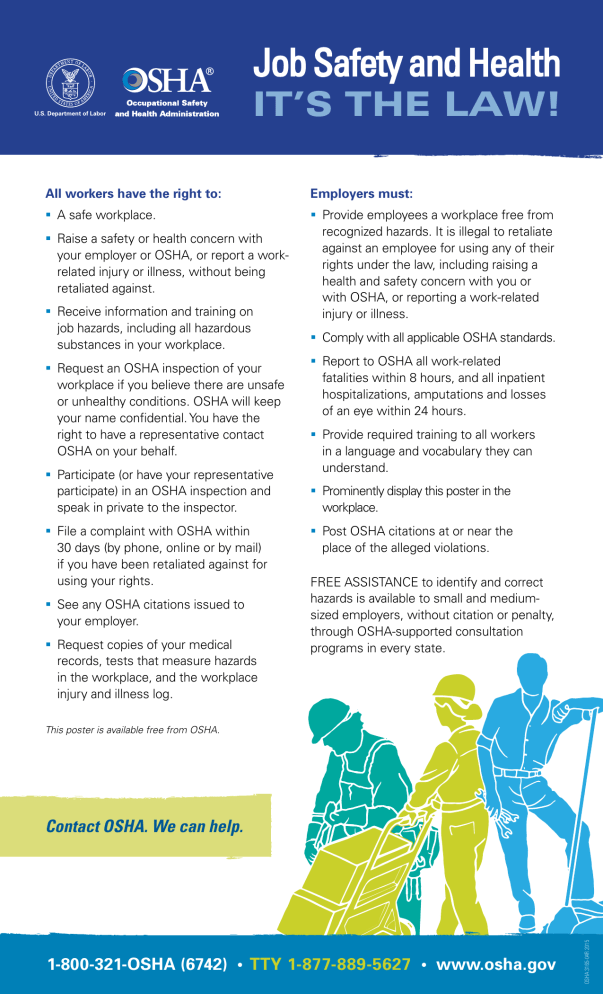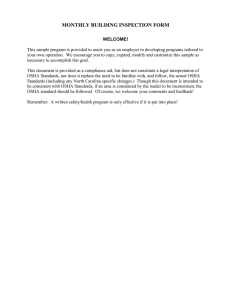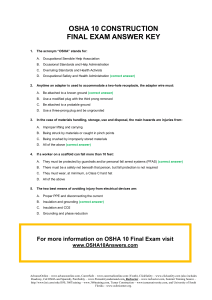
Job Safety and Health U.S. Department of Labor IT’S THE LAW! All workers have the right to: Employers must: A safe workplace. Provide employees a workplace free from recognized hazards. It is illegal to retaliate against an employee for using any of their rights under the law, including raising a health and safety concern with you or with OSHA, or reporting a work-related injury or illness. Raise a safety or health concern with your employer or OSHA, or report a workrelated injury or illness, without being retaliated against. Receive information and training on job hazards, including all hazardous substances in your workplace. Request an OSHA inspection of your workplace if you believe there are unsafe or unhealthy conditions. OSHA will keep your name confidential. You have the right to have a representative contact OSHA on your behalf. Participate (or have your representative participate) in an OSHA inspection and speak in private to the inspector. File a complaint with OSHA within 30 days (by phone, online or by mail) if you have been retaliated against for using your rights. See any OSHA citations issued to your employer. Request copies of your medical records, tests that measure hazards in the workplace, and the workplace injury and illness log. Comply with all applicable OSHA standards. Report to OSHA all work-related fatalities within 8 hours, and all inpatient hospitalizations, amputations and losses of an eye within 24 hours. Provide required training to all workers in a language and vocabulary they can understand. Prominently display this poster in the workplace. Post OSHA citations at or near the place of the alleged violations. FREE ASSISTANCE to identify and correct hazards is available to small and mediumsized employers, without citation or penalty, through OSHA-supported consultation programs in every state. This poster is available free from OSHA. 1-800-321-OSHA (6742) • TTY 1-877-889-5627 • www.osha.gov OSHA 3165-04R 2015 Contact OSHA. We can help. HANDOUT #2 Employers Must Provide and Pay for PPE Personal Protective Equipment (PPE) The Occupational Safety and Health Administration (OSHA) requires that employers protect you from workplace hazards that can cause injury or illness. Controlling a hazard at its source is the best way to protect workers. However, when engineering, work practice and administrative controls are not feasible or do not provide sufficient protection, employers must provide personal protective equipment (PPE) to you and ensure its use. PPE is equipment worn to minimize exposure to a variety of hazards. Examples include items such as gloves, foot and eye protection, protective hearing protection (earplugs, muffs), hard hats and respirators. Employer Obligations 9 Performing a "hazard assessment" of the workplace to identify and control physical and health hazards. 9 Identifying and providing appropriate PPE for employees. 9 Training employees in the use and care of the PPE. 9 Maintaining PPE, including replacing worn or damaged PPE. 9 Periodically reviewing, updating and evaluating the effectiveness of the PPE program. Workers should: 9 Properly wear PPE 9 Attend training sessions on PPE 9 Care for, clean and maintain PPE, and 9 Inform a supervisor of the need to repair or replace PPE. Employers Must Pay for Personal Protective Equipment (PPE) On May 15, 2008, a new OSHA rule about employer payment for PPE went into effect. With few exceptions, OSHA now requires employers to pay for personal protective equipment used to comply with OSHA standards. The final rule does not create new requirements regarding what PPE employers must provide. The standard makes clear that employers cannot require workers to provide their own PPE and the worker’s use of PPE they already own must be completely voluntary. Even when a worker provides his or her own PPE, the employer must ensure that the equipment is adequate to protect the worker from hazards at the workplace. Examples of PPE that Employers Must Pay for Include: Metatarsal foot protection Rubber boots with steel toes Non-prescription eye protection Prescription eyewear inserts/lenses for full face respirators Goggles and face shields April 2017 Fire fighting PPE (helmet, gloves, boots, proximity suits, full gear) Hard hats Hearing protection Welding PPE A-4 HANDOUT #2 Employers Must Provide and Pay for PPE Payment Exceptions under the OSHA Rule Employers are not required to pay for some PPE in certain circumstances: Non-specialty safety-toe protective footwear (including steel-toe shoes or boots) and nonspecialty prescription safety eyewear provided that the employer permits such items to be worn off the job site. (OSHA based this decision on the fact that this type of equipment is very personal, is often used outside the workplace, and that it is taken by workers from jobsite to jobsite and employer to employer.) Everyday clothing, such as long-sleeve shirts, long pants, street shoes, and normal work boots. Ordinary clothing, skin creams, or other items, used solely for protection from weather, such as winter coats, jackets, gloves, parkas, rubber boots, hats, raincoats, ordinary sunglasses, and sunscreen Items such as hair nets and gloves worn by food workers for consumer safety. Lifting belts because their value in protecting the back is questionable. When the employee has lost or intentionally damaged the PPE and it must be replaced. OSHA Standards that Apply OSHA General Industry PPE Standards 1910.132: General requirements and payment 1910.133: Eye and face protection 1910.134: Respiratory protection 1910.135: Head protection 1910.136: Foot protection 1910.137: Electrical protective devices 1910.138: Hand protection OSHA Construction PPE Standards 1926.28: Personal protective equipment 1926.95: Criteria for personal protective equipment 1926.96: Occupational foot protection 1926.100: Head protection 1926.101: Hearing protection 1926.102: Eye and face protection 1926.103: Respiratory protection There are also PPE requirements in shipyards and marine terminals and many standards on specific hazards, such as 1910.1030: Bloodborne pathogens and 1910.146: Permit-required confined spaces. OSHA standards are online at www.osha.gov. Sources: Employers Must Provide and Pay for PPE, New Jersey Work Environment Council (WEC) Fact Sheet OSHA Standards, 1910.132(h) and 1926.95(d) Employer Payment for Personal Protective Equipment Final Rule, Federal Register: November 15, 2007 (Volume 72, Number 220 April 2017 A-5 HANDOUT #3 April 2017 A-6 HANDOUT #3 April 2017 A-7 HANDOUT #3 8 We Are OSHA We Can Help Workers’ rights under the OSH Act Workers are entitled to working conditions that do not pose a risk of serious harm. To help assure a safe and healthful workplace, OSHA also provides workers with the right to: • Ask OSHA to inspect their workplace; • Use their rights under the law without retaliation; • Receive information and training about hazards, methods to prevent harm, and the OSHA standards that apply to their workplace. The training must be in a language you can understand; • Get copies of test results done to find hazards in the workplace; • Review records of work-related injuries and illnesses; and • Get copies of their medical records. Occupational Safety and Health Administration U.S. Department of Labor Who OSHA covers Private sector workers Most employees in the nation come under OSHA’s jurisdiction. OSHA covers private sector employers and employees in all 50 states, the District of Columbia, and other U.S. jurisdictions either directly through Federal OSHA or through an OSHA-approved state program. State-run health and safety programs must be at least as effective as the Federal OSHA program. To find the contact information for the OSHA Federal or State Program office nearest you, call 1-800-321OSHA (6742) or go to www.osha.gov. State and local government workers Employees who work for state and local governments are not covered by Federal OSHA, but have OSH Act protections if they work in those states that have an OSHA-approved state program. The following 22 states or territories have OSHA-approved programs: Alaska Arizona California Hawaii Indiana Iowa Kentucky Maryland Michigan Minnesota Nevada New Mexico North Carolina Oregon South Carolina Tennessee Utah Vermont Virginia Washington Wyoming Puerto Rico Five additional states and one U.S. territory have OSHA-approved plans that cover public sector workers only: Connecticut Illinois Maine New Jersey New York Virgin Islands Private sector workers in these five states and the Virgin Islands are covered by Federal OSHA. Federal government workers Federal agencies must have a safety and health program that meets the same standards as private employers. Although OSHA does not fine federal agencies, it does monitor federal agencies and responds to workers’ complaints. The United States Postal Service (USPS) is covered by OSHA. Not covered under the OSH Act: • Self-employed; • Immediate family members of farm employers who do not employ outside employees; • Workplace hazards regulated by another federal agency (for example, the Mine Safety and Health Administration, the Department of Energy, or Coast Guard). OSHA standards: Protection on the job OSHA standards are rules that describe the methods that employers must use to protect their employees from hazards. There are OSHA standards for Construction work, Agriculture, Maritime operations, and General Industry, which are the standards that apply to most worksites. These standards limit the amount of hazardous chemicals workers can be exposed to, require the use of certain safe practices and equipment, and require employers to monitor hazards and keep records of workplace injuries and illnesses. Examples of OSHA standards include requirements to provide fall protection, prevent trenching cave-ins, prevent some infectious diseases, assure that workers safely enter confined spaces, prevent exposure to harmful substances like asbestos, put guards on machines, provide respirators or other safety equipment, and provide training for certain dangerous jobs. Employers must also comply with the General Duty Clause of the OSH Act, which requires employers to keep their workplace free of serious recognized hazards. This clause is generally cited when no OSHA standard applies to the hazard. Workers can ask OSHA to inspect their workplace Workers, or their representatives, may file a complaint and ask OSHA to inspect their workplace if they believe there is a serious hazard or that their employer is not following OSHA standards. A worker can tell OSHA not to let their employer know who filed the complaint. It is a violation of the OSH Act for an employer to fire, demote, transfer or retaliate in any way against a worker for filing a complaint or using other OSHA rights. Written complaints that are signed by a worker or their representative and submitted to the closest OSHA office are more likely to result in an on-site OSHA inspection. You can call 1-800321-OSHA (6742) to request a complaint form from your local OSHA office or visit www.osha. gov/pls/osha7/eComplaintForm.html to submit the form online. Completed forms can also be faxed or mailed to the local OSHA office. Most complaints sent in online may be resolved informally over the phone with your employer. When the OSHA inspector arrives, workers and their representatives have the right to: • Go along on the inspection; • Talk privately with the OSHA inspector; and • Take part in meetings with the inspector and the employer before and after the inspection is conducted. Where there is no union or employee representative, the OSHA inspector must talk confidentially with a reasonable number of workers during the course of the investigation. When an inspector finds violations of OSHA standards or serious hazards, OSHA may issue citations and fines. A citation includes the methods an employer may use to fix a problem and the date by when the corrective actions must be completed. Workers only have the right to challenge the deadline for when a problem must be resolved. Employers, on the other hand, have the right to contest whether there is a violation or any other part of the citation. Workers or their representatives must notify OSHA that they want to be involved in the appeals process if the employer challenges a citation. If you send in a complaint requesting an OSHA inspection, you have the right to find out the results of the OSHA inspection and request a review if OSHA does not issue citations. Employer responsibilities Employers have the responsibility to provide a safe workplace. Employers MUST provide their employees with a workplace that does not have serious hazards and must follow all OSHA safety and health standards. Employers must find and correct safety and health problems. OSHA further requires employers to try to eliminate or reduce hazards first by making changes in working conditions rather than just relying on masks, gloves, earplugs or other types of personal protective equipment. Switching to safer chemicals, implementing processes to trap harmful fumes, or using ventilation systems to clean the air are examples of effective ways to get rid of or minimize risks. Employers MUST also: • Prominently display the official OSHA Job Safety and Health – It’s the Law poster that describes rights and responsibilities under the OSH Act. This poster is free and can be downloaded from www.osha.gov. • Inform workers about chemical hazards through training, labels, alarms, color-coded systems, chemical information sheets and other methods. • Provide safety training to workers in a language and vocabulary they can understand. • Keep accurate records of work-related injuries and illnesses. • Perform tests in the workplace, such as air sampling, required by some OSHA standards. • Provide required personal protective equipment at no cost to workers.* • Provide hearing exams or other medical tests required by OSHA standards. • Post OSHA citations and injury and illness data where workers can see them. • Notify OSHA within 8 hours of a workplace fatality or within 24 hours of any workrelated inpatient hospitalization, amputation or loss of an eye (1-800-321-OSHA [6742]). • Not retaliate against workers for using their rights under the law, including their right to report a work-related injury or illness. * Employers must pay for most types of required personal protective equipment. The law protects workers from retaliation when using their OSHA rights The OSH Act protects workers who complain to their employer, OSHA or other government agencies about unsafe or unhealthful working conditions in the workplace or environmental problems. You cannot be transferred, denied a raise, have your hours reduced, be fired, or punished in any other way because you used any right given to you under the OSH Act. Help is available from OSHA for whistleblowers. If you have been punished or retaliated against for using your rights, you must file a complaint with OSHA within 30 days from the date the retaliatory decision was both made and communicated to you. No form is needed, but you must call OSHA within 30 days of the alleged retaliation at 1-800-321-OSHA (6742) and ask to speak to the OSHA area office nearest you to report the retaliation. You have the right to a safe workplace The Occupational Safety and Health Act of 1970 (OSH Act) was passed to prevent workers from being killed or seriously harmed at work. The law requires that employers provide their employees with working conditions that are free of known dangers. The Act created the Occupational Safety and Health Administration (OSHA), which sets and enforces protective workplace safety and health standards. OSHA also provides information, training and assistance to workers and employers. Workers may file a complaint to have OSHA inspect their workplace if they believe that their employer is not following OSHA standards or there are serious hazards. Contact us if you have questions or want to file a complaint. We will keep your information confidential. We are here to help you. Call our toll-free number at 1-800-321-OSHA (6742) or go to www.osha.gov. Occupational Safety and Health Administration 1-800-321-OSHA (6742) TTY 1-877-889-5627 www.osha.gov OSHA 3334-09R 2015


